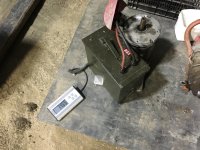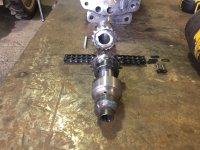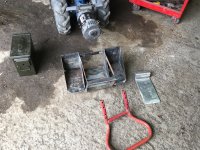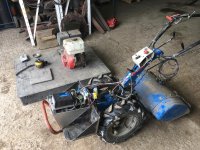Hi All.
I've checked in on this thread a couple times over the years to see if anyone had made any progress because it's a project I've considered for a while. Until recently it just didn't seem to be a realistic project because of battery power and weight limitations (lead delivers low current unless hundreds of pounds and that's no good for a 2-wheeler).
With the advent of good lithium batteries at prices even a farmer can stomach it seemed to me that the constraints of the problem were loosening and after I used some Chevrolet Volt battery modules to update a utility cart for our farm (
meet Bob here) I started dreaming about converting our BCS to battery-electric. By sharing 24V battery modules with a couple other tools (Crown pallet truck and others not yet built) I could broaden the benefit of
building up robust portable batteries, thus diluting associated expense and also increasing runtime for any one tool because it could borrow from the fleet of shared batteries. Like cordless power tools but 42Ah at 24V instead of 2 or 4Ah at 18 or 20V. The bricks are 1kWh meaning they can provide 1000W steadily for 60 minutes but because they're lithium they can also provide outrageous peak power - thousands of amps - so need to be carefully fused etc. Do your homework before you start playing with bigger lithium batteries.
So far I have one brick assembled and working and parts for 4 more. So far the brick is great and I think they'll prove robust enough for the tasks. For battery geeks out there I'm not running a BMS with these but have cell balance monitor/low voltage alarm and a balance charger, all borrowed from RC hobbyist industry to keep batteries monitored and balanced. The photo below shows a completed 24V power brick and the motor that eventually went on my BCS sitting on a scale and showing weight in kg.

With the batteries sorted out it was the BCS electric drivetrain that needed attention. Our BCS is a circa 2001 model 730GX11 though I guess I could rebadge it 730E when I'm done. I found what turns out to be a perfect DC motor in an industrial auction (Advanced Motors and Drives DD0-4002 aka 2450003). I built an adapter plate to fit the DC motor to the existing motor mount "cone" and replaced the clutch with a driveline fabricated out of a scrap BCS clutch and a variety of other adapters and bits, joined, welded, turned, etc.

A cradle made entirely out of head-scratching and scrap metal now carries one or two batteries to either side of the electric motor and also carries an Alu plate with the motor controller (Curtis 1243), main contactor (Albright SW80) and a main fuse/ammeter. The battery cradle subframe also manages airflow for proper cooling of motor and controller and protects the motor from aspiring bits of flammable crap like grass for instance, into the motor (airflow-managemetn not yet finished in pic below).

Total drivetrain weight is higher than for gas equivalent but by using two batteries wired in parallel I can choose to use one or two as needed, depending on how heavy an implement is attached at the other end. We have a very heavy 21" rotary harrow that NEEDs both batteries in order to balance (gas engine needs almost 20kg weight on bumper) but the stock 26" rototiller balances well with just one battery. So far the weight difference seems to be a non-issue because of the modular battery approach. here's a pic of gas and electric drivetrains side by side. bumper and motor-mount cone at front right of pallet are common to both.

I finally got rough controls worked out and
tested the electric drivetrain two days ago. It works like a charm and I have high hopes that 2018 will be it's first season as an electric 2-wheel tractor, being put to work on our farm. I need to redo all the controls and control wiring and still build a cowl/cover for the controller and some other bits but with 2 or 3 more days in the shop it ought to be ready for prime time. For now I actually had to pull it apart and put the Honda engine and clutch back on because we need to prep a lot of greenhouse beds and those 2 or 3 days of shop time are not presently available.

Why we are doing this: We actually built a big new greenhouse last year for season extension and the area to be prepped indoors was what motivated me to tackle this project now. The electric drivetrain is not silent and even some tools are noisy, but it doesn't require ear protectors like a gas engine does and, more importantly, it doesn't make noxious fumes for you or the people around you if several are working in the GH at once. That's the main motivator for us because it's hard to argue that the Honda GX340 engine wasn't doing everything else absolutely perfectly. The conversion will probably cost us close to $1200 with 2 years of reflection and scavenging and almost all used parts. Figure more like $3000 to do it with all new parts and maybe $5000 to have someone do it for you.
So the tech is now here at last, even for scavengers like me (90% of parts on this build are used) but unless you have a lot of indoor growing space it's probably not a justifiable expense to convert your BCS or other 2-wheel tractor to electric power. It just costs too much in money or time because there are effectively NO off-the-shelf solutions to any of it. Also, it's a tough sell arguing to replace a Honda GX engine because they are probably among the best small gas engines ever built. So unless you've got a strong technical bent, a lot of time and a really strong desire to do this it's probably not the way to go. BUT... it is now possible.
There are loads of pics of the build on my FaceBook page if you don't hate Facebook - search for Reid Allaway - and a couple videos on YouTube - again search my name.
I'm glad to finally have a chance to update this thread with some good news. Please let me know if you're working on a similar project and remember, if you see a crashed Chevy Volt or Nissan Leaf please make sure everyone is okay... and then make them an offer on the car's battery

~ Reid Allaway
Tourne-Sol Co-operative Farm, les Cèdres, QC, CAN




